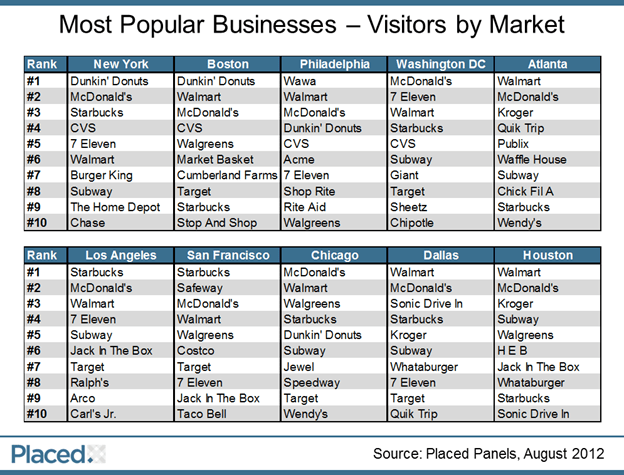
Last week, I had a long-overdue conversation with Placed CEO David Shim, in advance of the company’s Placed Panels launch yesterday (more on that in a bit). This is part of our ongoing dialogues with companies in the emerging location analytics space.
For those unfamiliar, Placed works with app developers and publishers to allow them to get a better sense of what their users are doing in the offline world. This can be vital information for product research, market intelligence, or effective ad targeting.
For example, working with a national newspaper publisher, it can help determine what markets users are consuming content and other granular behavioral data. This can aid in product planning or selling advertisers into different demographic or behavioral profiles.
Users of a given app can be measured to see that in the aggregate, 8% are likely to be near a McDonalds or 12% are likely to be near a Starbucks. This has marketing implications for these chains, as well as their competitors or complimentary products.
According to Shim, Placed offers this data for free, and will begin to monetize after an ecosystem is formed around its use. There are also many upsell possibilities such triangulating different data sets to discern deeper levels of understanding of user behavior.
With that backdrop, the company this week launches its Placed Panels product. This fulfills a longstanding hole in offline consumer behavioral research by applying pervasive location tracking to an opted-in panel of users (think comscore for offline).
This goes far beyond location analytics such as check-ins or periodic ad requests. Tracking location in a more pervasive way can give app publishers richer mosaic of location information and user behavior as they bounce from place to place in the real world.
The way this works is that publishers integrate the functionality, then sign up their users to be tracked. This generally comes with some sort of financial incentive to be tracked for a set time period that ranges from 30 to 90 days.
Shim stresses that privacy concerns are sidestepped in that it’s based on a few levels of user opt-in, such as downloading and keeping the tracking app. Users can opt out any time and all data is aggregated and anonymized.
The outcome will be some powerful user behavior intel — in line with some of the triangulated data sets we’ve written about from the likes of JiWire. The pervasive nature of the tracking will make it that much more robust and uncover all kinds of new data.
One thing that comes to mind is tracking the effectiveness of marketing campaigns. Given that user behavior and proximity to real world locations can be measured, showing up at a store after seeing an ad now becomes a bit more transparent in the aggregate.
Some of the data uncovered will be interesting to analysts like us, while other data will indicate new user behavior that represents targeting opportunities for brands and publishers. That could in turn uncover all new ways for Placed to monetize its offering.


This Post Has 0 Comments